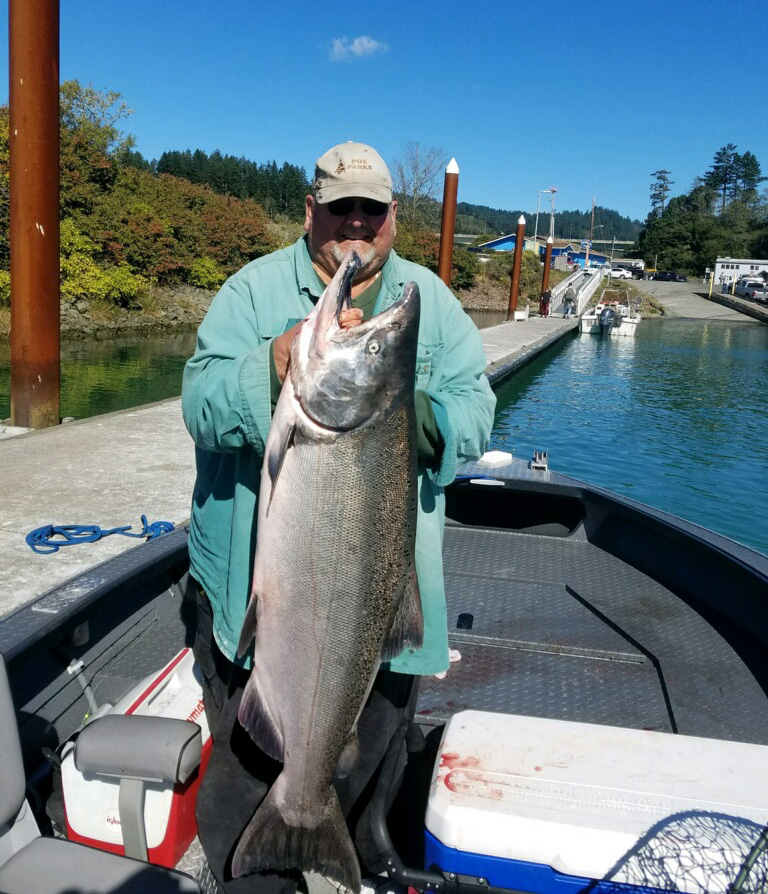
Hawg Chinook Caught in the Bubble Fishery

by Larry Ellis
10-14-2017
Website
I love being right.
Last week I said that I wouldn't be surprised one bit if a 50-pound king was caught in the Chetco Bubble Fishery.
No sooner did the Curry Coastal Pilot hit the newsstand that a 49.83-pound Chinook was caught in the ocean by Don Williams of Brookings while trolling a cut-plug herring.
While 49.83 pounds does not technically qualify as a legitimate 50-pound fish, it's close enough for government work. In pounds and ounces 49.83 translates to 49-pounds 13.28 ounces, and any way you slice it, that's a Chetco hawg!
And there's a lot of big 40-pound-plus Chinook doing the backstroke in the ocean and in the Chetco Bay right now.
Don's fish was caught near the red can buoy in the afternoon as winds started to kick up. The red can is called so because it is red and it is a can buoy, as opposed to a nun buoy. The red can buoy is also known as the bell.
It's a place where fish will stack up like cordwood when a front of some sort is approaching. These fish are getting ready to head up the Chetco River when rain is imminent. The red can is also a place where boats feel somewhat safe from the elements when the wind kicks up a notch.
Last week I referred to the red can as turning into Boat City when the weather turns sour.
Here's Williams' account of his experience with the Chetco toad.
"It was an epic fight," recounts Williams. "I fought that fish for about 30 minutes. It made two 100-foot runs and then it made a 150-foot run. That's before it dove for the bottom."
Meanwhile Williams and his friend were taking water over the back of the boat, getting soaked by the waves as they were basically back-trolling to keep the fish underneath the boat.
"The wind came up and it got pretty choppy out there," recalls Williams. "The wind wasn't too bad when we hooked the fish but while we were landing it, it was blowing pretty good. And then the fish made four really deep, straight down power runs. We were fishing in about 80 feet of water, so those four deep runs were about 60 feet each."
When you're fighting a salmon as big as the one Williams had on his line, patience is the name of the game. Eventually the fish will tire itself out, even on the 30-pound test that Williams was using for his mainline.
"I fought that fish until it gave up and we were finally able to get it in the net," noted Williams. "I weighed the fish on the boat three times on a good calibrated digital scale and each weight was within 1 decimal point of the same weight, so I am pretty confident on the fish's weight."
And according to the length and girth of the fish, so am I. In fact, the fish probably was over 50 pounds according to the length and girth formula of estimating the weight of a fish.
The formula for estimating the weight of a fish is multiplying the length by the girth squared, divided by 740. The fish's length was 44 inches and its girth was 31 inches.
In the case, 44 X 31 X 31 divided by 740 equals 57 pounds.
So what's going to happen in this weekends' bubble fishery? Anglers are first hoping for some decent weather. The National Weather Service is predicting that the wind will be blowing in the neighborhood of 10 to 12 knots on Saturday and between 5 and 8 knots on Sunday.
If the weather is on the bitter side, people will be fishing near the red can, which is about 1/2 mile from the jaws. If the weather is undoable, then the Chetco Bay will be catching most of the heat.
Remember that these fish will eventually be going up the Chetco River. They will be heading up to the tidewater holes on the incoming high tide and pushing back downriver into the bay or the ocean as the tide recedes.
Also remember that cut-plug herring works quite well for this ocean fishery, so that should definitely be a back-up plan. Don Williams was using straight bait - in other words, no flasher, just a naked cut-plug herring. So whether you decide to use a flasher or not is your choice.
Tight lines!
Larry Ellis, author, writer, columnist and photographer has had a 50-year passion for fishing in California and Oregon's saltwater and freshwater venues. He is a well-known writer for Oregon, Washington and California Fishing and Hunting News, Northwest Sportsman, California Sportsman and Pacific Coast Sportfishing. He currently writes monthly for Salmon Trout Steelheader Magazine, and is the author of two books, "Plug Fishing for Salmon" and "Buoy 10, the World's Largest Salmon Run." Both books can be bought from Amato Publications (amatobooks.com), Amazon and eBay. Ellis particularly loves living in his hometown of Brookings, Oregon - The heart of salmon country and gateway to fishing paradise.
Website Hosting and Design provided by TECK.net
Fish Database content provided by the Fish Reports Network.